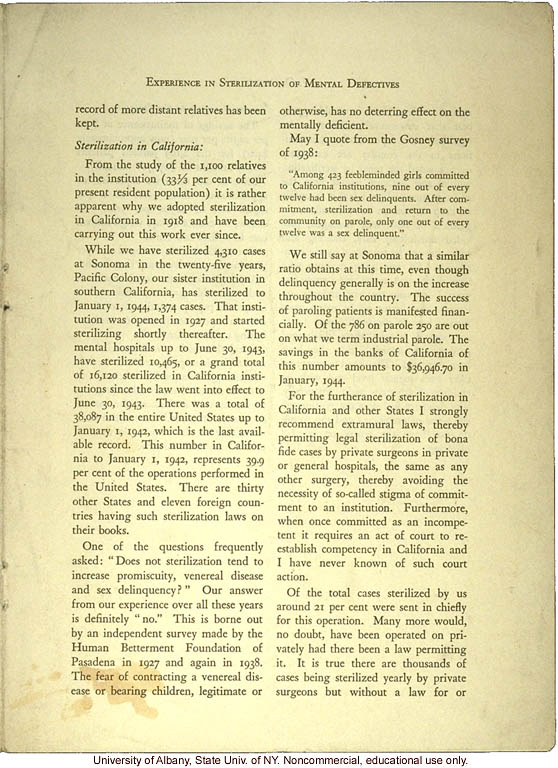Experience in Sterilization of Mental Defectives
record of more distant relatives has been kept.
Sterilization in California:
From the study of the 1,100 relatives in the institution (33 1/3 per cent of our present resident population) it is rather apparent why we adopted sterilization in California in 1918 and have been carrying out this work ever since.
While we have sterilized 4,310 cases at Sonoma in the twenty-five years, Pacific Colony, our sister institution in southern California, has sterilized to January 1, 1944, 1,374 cases. That institution was opened in 1927 and started sterilizing shortly thereafter. The mental hospitals up to June 30, 1943, have sterilized 10, 465, or a grand total of 16,120 sterilized in California institutions since the law went into effect to June 30, 1943. There was a total of 38,087 in the entire United States up to January 1, 1942, which is the last available record. This number in California to January 1, 1942, represents 49,9 per cent of the operation performed in the United States. There are thirty other States and eleven foreign countries having such sterilization laws on their books.
One of the questions frequently asked: "Does sterilization tend to increase promiscuity, venereal disease and sex delinquency?" Our answer from our experience over all these years is definitely "no." This is borne out by an independent survey made by the Human Betterment Foundation of Pasadena in 1927 and again in 1938. The fear of contracting a venereal disease or bearing children, legitimate or otherwise, has no deterring effect on the mentally deficient.
May I quote from the Gosney survey of 1938:
[extract]"Among 423 feebleminded girls committed to California institutions, nine out of every twelve had been sex delinquents. After commitment, sterilization and return to the community on parole, only one out of every twelve was a sex delinquent."[end extract]
We still say at Sonoma that a similar ratio obtains at this time, even though delinquency generally is on the increase throughout the country. The success of paroling patients is manifested financially. Of the 786 on parole 250 are out on what we term industrial parole. The savings in the banks of California of this number amounts to $36,946.70 in January, 1944.
For the furtherance of sterilization in California and other States I strongly recommend extramural laws, thereby permitting legal sterilization of bona fide cases by private surgeons in private or general hospitals, the same as any other surgery, thereby avoiding the necessity of so-called stigma of commitment to an institution. Furthermore, when once committed as an incompetent it requires an act of court to re-establish competency in California and I have never known of such court action.
Of the total cases sterilized by us around 21 per cent were sent in chiefly for this operation. Many more would, no doubt, have been operated on privately had there been a law permitting it. It is true there are thousands of cases being sterilized yearly by private surgeons but without a law for or
[end]


